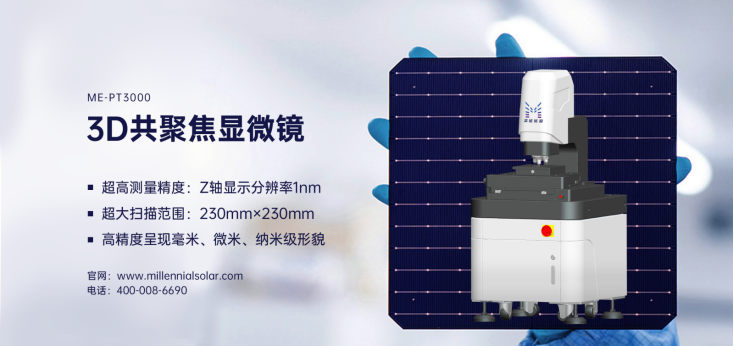
量子效率测试仪
PL/EL一体机
Sinton硅片少子寿命测试仪
Sinton硅块少子寿命测试仪
绒面反射率测试仪
3D共聚焦显微镜
清洗制绒工作站
在线四探针方阻测试仪
全自动扫描四探针方阻测试仪
在线薄膜厚度测试仪
晶化率测试仪
Horiba显微共焦拉曼光谱仪
傅里叶红外光谱仪
霍尔效应测试仪
分光光度计
全光谱椭偏仪
Horiba椭圆偏振光谱仪
TLM接触电阻率测试仪
超景深显微镜
网版智能影像测量仪
全自动影像测量仪
卧式拉力机
电池片稳态光衰老化试验箱
电池片紫外老化试验箱
电池片拉脱力综合测试仪
外观检验台
湿漏电测试系统
组件实验室EL测试仪
紫外老化试验箱
稳态光衰老化试验箱
电流连续性监测系统
PID测试系统
旁路二极管测试系统
LeTID测试系统
反向电流过载系统
脉冲电压测试系统
绝缘耐压测试仪
接地连续性测试仪
绝缘耐压接地测试仪
湿热环境试验箱
湿冻环境试验箱
热循环试验箱
动态机械载荷测试机
静态机械载荷测试机
冰雹冲击试验机
引出端强度试验机
霰弹冲击试验机
抗划伤(切割)测试机
剥离试验机
万能材料试验机(单臂)
万能材料试验机(双臂)
光伏玻璃透过率测试仪
醋酸测试试验箱
交联度测试系统
二极管接线盒综合测试仪
落球冲击试验机
半自动四探针
全自动探针式台阶仪
多通道太阳能MPPT系统
Horiba稳瞬态荧光光谱仪
钙钛矿P1激光划线测试仪
钙钛矿在线膜厚测试仪
钙钛矿工艺检测工作站
手持式IV测试仪
便携式EL测试仪
手持热成像测试仪
户外组件IV测试仪
户外组件多通道测试系统
光伏逆变器电能质量测试仪
无人机EL检测仪
N型光伏电池降本增效:铜电镀技术驱动行业发展
日期:2024-03-22浏览量:15
铜电镀技术是近年来异质结电池实现降本增效的重要技术路线之一,其优势在于比传统银浆的导电性能强,且低接触电阻,使用铜电镀技术可提升转换效率。在银价不断波动的市场行情下,铜电镀技术受到诸多生产商关注,发展情况持续向好。美能3D共聚焦显微镜,可通过非接触式扫描电池表面并建立表面3D图像,对栅线的高度与宽度、绒面上的金字塔数量进行定量检测,以反馈其中的清洗制绒、栅线的工艺质量。本期将给大家介绍铜电镀制作栅线技术。

铜电镀电极提效基本原理
铜电镀是一种非接触式的电极金属化技术,其工艺的基本原理是在基体金属表面上通过电解化学反应沉积金属铜来制作铜栅线,收集光伏效应产生的载流子。铜电镀技术与传统丝网印刷技术的主要差异,是在ITO工序后。传统的异质结产线会在ITO工序后进行银浆印刷和烧结,而铜电镀工艺主要分为栅线的图形化与金属化这两部分工序,在图形化部分的ITO工序后,不使用银浆,而是使用铜来电镀。

使用美能3D共聚焦显微镜测量的铜电镀栅线图
铜电镀工艺环节
异质结太阳能电池铜电镀工艺主要包括:种子层制备、图形化、金属化(电镀)、后处理四大工艺环节,各环节工艺复杂,存在多种技术路线,设备原理差异大。
● 在种子层制备环节,物理气相沉积法(PVD)为制备主流技术方案。直接在TCO上电镀,镀层和TCO间的接触为物理接触,附着力主要为范德华力,容易引起电极脱落,且在TCO上电镀金属是非选择性的,需在电镀之前在透明导电薄膜表面沉积种子层(一般为100nm),增加电镀金属与TCO之间的附着性能。
● 在图形化制作环节,目前存在的技术路线主要包括:光刻路线、激光路线和喷墨打印路线,其中以感光油墨为原料的曝光显影光刻路线是图形化主流技术方案。
● 在金属化电镀环节,存在垂直、水平电镀,插片式电镀等多种主流技术方案。
● 在后处理环节中,主要处理方法包括热处理、化学、机械处理等,目的是改善电镀铜电极的性能和外观。

铜电镀技术在异质结太阳能电池中的工艺流程图
电镀铜电极的性能包括导电性、化学稳定性、机械强度等方面。
● 导电性是电镀铜电极最近本的性能之一,可以通过控制电镀液的成分和工艺条件等方法来优化。
● 化学稳定性是电镀铜电极在电池中长期稳定性的重要指标,可以通过添加稳定剂等方法来提高。
● 机械强度是电镀铜电极在制备和使用过程中的重要性能之一,可以通过控制电镀液的成分和工艺条件方法来优化。
铜栅线相比于传统银栅线的优缺点有哪些?
栅线需要与电池片的基体材料形成一个非常好的接触,即欧姆接触。欧姆接触的好坏决定了电池的导电性以及发电效率是否能够达到最佳。接触面能否紧密结合、栅线材料对电子或载流子通过的阻抗(电阻率)都会影响欧姆接触的好坏。电阻率越大,电池片对电子或载流子的负荷越高,电子或载流子的通过率越差。
优点:
1. 银浆的导电性比铜栅线的导电性弱。因为银浆是混合物,是流动的胶体,而铜栅线是纯铜,所以铜栅线体电子比银浆体电子的电阻率更低。
2. 银浆印刷的线宽比铜电镀的线宽更宽,导致了银浆印刷的发电效率更低。
缺点:
1. 铜电镀的栅线更细,这会导致铜电镀面临栅线是否会更牢固、附着力能否达到组件生产要求的问题。因为栅线更细,附着面积更小,所以在同样应力条件下,铜栅线的附着力不够,铜栅线比银栅线更容易脱落,而栅线脱落会导致栅线接触出现问题,会影响电池片和组件后期的使用。
优化方向:利用半导体的工艺进行图形化,可以使铜电镀的栅线宽度达到10μm。
2. 经过长期使用,银浆不会出现氧化失效的问题,而铜栅线会出现氧化失效问题。铜只要暴露在空气中就会以非常快的速度氧化,出现氧化铜或者氧化亚铜,从而影响铜的导电性。铜的氧化物还会扩散,铜在ITO等特定条件中的扩散非常缓慢,但是铜氧化后会一直扩散,这会导致栅线电池片或者组件失效。
优化方向:对栅线进行保护,或进行抗氧化处理。
铜电镀降本提效优势更明显
铜电镀是一种完全无银化的颠覆性降本技术。传统丝网印刷工艺中,低温银浆中银粉占据90%左右,其余部分材料为分散性粘结剂和玻璃粉等,采用电镀铜后,电池正面的遮光损失进一步降低,栅线的电阻损耗也全面减少,随着电极与TCO接触得到全面改善,低成本电极制备可以实现规模量产,这为电池金属化工艺的发展提供了新方向。这种全新技术不仅可以全面降低成本,而且可以进一步提高效率。

采用丝网印刷和铜电镀方案的异质结电池的金属化成本计算
美能3D显微镜

美能3D共聚焦显微镜是以光学技术为原理、结合精密Z向扫描模块、3D建模算法等对器件表面进行非接触式扫描并建立表面3D图像,通过系统软件对栅线的高度与宽度、绒面上的金字塔数量进行定量检测,以反馈其中的清洗制绒、栅线的工艺质量。
精确可靠的3D测量,实现实时共聚焦显微图像
超高共聚焦镜头,Z轴显示分辨率可达1nm
198-39966倍最大综合倍率,精确测量亚微米级形貌
全自动栅线绒面测量,快速生成数据
近年来,光伏装机量持续提升,让行业成本压力陡增,而解决HJT电池银浆成本高的痛点,让铜电镀产业发展成为了行业刚需。栅线的形貌、高宽比、线宽比对N型太阳能电池效率转换影响较大,精准把控工艺质量至关重要。




































































